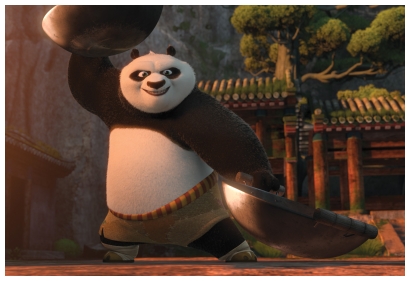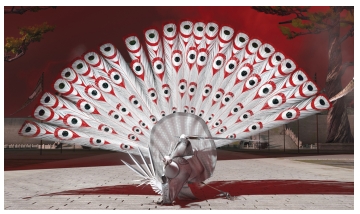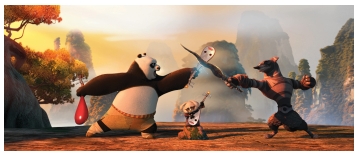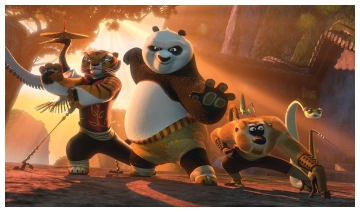 I blame fuckin' Shrek.
I blame fuckin' Shrek.
Now, realistically, one shouldn't go blaming things on a highly popular but ultimately fictional ogre. But how else to explain the attitude I had going into Kung Fu Panda 2, the new film out of DreamWorks Animation and the continuation of the saga of an ursine martial arts master and his quest for identity in an anthropomorphic, medieval China? The dread I felt stemmed directly from the knowledge that the Shrek sequels took everything good about the first film, and trashed them with ham-handed comedy, self-conscious star voices, and a surfeit of pop culture references.
Despite the original Kung Fu Panda's reliance on the somewhat exhausted Jack Black earnest-slacker bit, directors John Wayne Stevenson and Mark Osborne delivered a fine entertainment, with beautiful production design, expressive character animation, and Dustin Hoffman amazingly sincere as kung fu guru (and red panda) Master Shifu. And while there appeared to be some reluctance to fully engage its Hong Kong inspirations, the film eventually succumbed, with the final half hour a sublime melding of martial arts action with the boundless physics of an animated film. The question was, would Kung Fu Panda 2 leverage off what was discovered in that final act, or would the Shrek factor hold sway?
Happily, the answer is that Kung Fu Panda 2 not only carries forward the first film's inspiration, but plusses it in ways that that stun and delight.
 The landscape sure as hell is larger. Where the original film focused itself mostly on the isolated Valley of Peace, 2's main adversary threatens the whole of China itself. He's Lord Shen (Gary Oldman) a megalomaniacal peacock with designs on the throne and a formidable arsenal of newly-invented cannons to back up the claim. It's up to the Furious Five of the original film -- Tigress (Angelina Jolie), Monkey (Jackie Chan), Mantis (Seth Rogen), Viper (Lucy Liu) and Crane (David Cross) -- plus Dragon Warrior Po (Jack Black), the titular panda, to defeat the tyrant. That's not going to be easy -- not only is Lord Shen heavily armed and a formidable master of martial arts, but his very presence cripples Po with a debilitating paralysis, triggering vague memories of an horrific genocide.
The landscape sure as hell is larger. Where the original film focused itself mostly on the isolated Valley of Peace, 2's main adversary threatens the whole of China itself. He's Lord Shen (Gary Oldman) a megalomaniacal peacock with designs on the throne and a formidable arsenal of newly-invented cannons to back up the claim. It's up to the Furious Five of the original film -- Tigress (Angelina Jolie), Monkey (Jackie Chan), Mantis (Seth Rogen), Viper (Lucy Liu) and Crane (David Cross) -- plus Dragon Warrior Po (Jack Black), the titular panda, to defeat the tyrant. That's not going to be easy -- not only is Lord Shen heavily armed and a formidable master of martial arts, but his very presence cripples Po with a debilitating paralysis, triggering vague memories of an horrific genocide.
Already, that's sounding heavier than the previous chapter. To her credit, helmer Jennifer Yuh Nelson -- directing from a script by Kung Fu Panda's Jonathan Aibel and Glenn Berger -- has realized that whatever gold there was to be mined from the bumbling-loser-in-over-his-head set-up, the first film exploited it to its fullest; time to move on. Yeah, the panda still stuffs his face at the most inappropriate moments, gets winded on short walks, and manages to misunderstand even the simplest of situations -- but that isn't what this film is about. Not satisfied with just expanding the physical terrain, Nelson has pushed the boundaries of the franchise's narrative, design, and action. And in doing so, she's brought in a welcome concept, one well-deployed in Asian pop culture: syncretism.
 Inelegantly put, syncretism is the process of incorporating foreign concepts into an existing one to form something new and unique. Nelson appears to have fully embraced the concept. Where the original film's prologue was a nicely 2D animated satire of a geek's sugar-fueled fantasy, 2 begins with the incorporation of a uniquely Asian storytelling style -- shadow puppetry -- brought to the 21st century through the addition of a delicate, computer-enhanced color palette. The bulk of the film follows the tip of one of the series' stars, Hong Kong legend Jackie Chan, who originally gained fame for the way his fight scenes conformed to and incorporated their surroundings. Much as a Jackie Chan battle in a shopping mall would use clothes racks, escalators, store displays, and the entire multi-level locale to fuel the melee, Kung Fu Panda 2, molds its action scenes to suit the situation: a battle in a musician's enclave recruits every building and object -- including one serenely strumming bunny -- into the fight; when the crew tries to liberate some potential but reluctant allies from a prison, their barred, iron door becomes a versatile tool/weapon, pivoting on multiple axes, redistributing combatants seemingly at random.
Inelegantly put, syncretism is the process of incorporating foreign concepts into an existing one to form something new and unique. Nelson appears to have fully embraced the concept. Where the original film's prologue was a nicely 2D animated satire of a geek's sugar-fueled fantasy, 2 begins with the incorporation of a uniquely Asian storytelling style -- shadow puppetry -- brought to the 21st century through the addition of a delicate, computer-enhanced color palette. The bulk of the film follows the tip of one of the series' stars, Hong Kong legend Jackie Chan, who originally gained fame for the way his fight scenes conformed to and incorporated their surroundings. Much as a Jackie Chan battle in a shopping mall would use clothes racks, escalators, store displays, and the entire multi-level locale to fuel the melee, Kung Fu Panda 2, molds its action scenes to suit the situation: a battle in a musician's enclave recruits every building and object -- including one serenely strumming bunny -- into the fight; when the crew tries to liberate some potential but reluctant allies from a prison, their barred, iron door becomes a versatile tool/weapon, pivoting on multiple axes, redistributing combatants seemingly at random.
Where KFP2 plusses the Chan approach is in its ability to use computer-generated animation to its fullest. This is nothing particularly unusual to CG features, but the level of mastery here is impressive. Cameras capture the action in grand, swirling moves, taking flight when necessary; and where live action has to satisfy itself with however many humans and weapons a budget can bear, there's no such bar in the virtual realm -- when the film goes big, it goes REALLY big. And, pax Pixar and James Cameron, with each DreamWorks Animation release I become more and more convinced of their superior approach to 3D filmmaking. The detailing is amazing, and sense of depth truly immersive. It's the too-rare instance where the process crosses over from mere gimmickry to a powerful, storytelling tool.
 So now that the Shrek curse has been broken -- at least in my mind -- what does the future hold for this series? KFP2 wraps up with an intriguing closing shot, but it's a long way (and probably at least a couple of years) between that tantalizing promise and a completed chapter three. It would be interesting if, having developed their prowess in ganging martial arts action to family-friendly entertainment, Nelson and her team turned that same transformative spirit to the storytelling itself, exploring themes beyond what here is really a stock set of plot-points, telling a tale that would find unique expression through the combined worlds of martial arts and animation.
So now that the Shrek curse has been broken -- at least in my mind -- what does the future hold for this series? KFP2 wraps up with an intriguing closing shot, but it's a long way (and probably at least a couple of years) between that tantalizing promise and a completed chapter three. It would be interesting if, having developed their prowess in ganging martial arts action to family-friendly entertainment, Nelson and her team turned that same transformative spirit to the storytelling itself, exploring themes beyond what here is really a stock set of plot-points, telling a tale that would find unique expression through the combined worlds of martial arts and animation.
I don't know what that might be, and I'm honestly not expecting that it would actually happen (nor, if the next film is as good as this, would I be profoundly disappointed if it didn't), but to deliver a tale that incorporates this level of visual artistry and moves us in a new and unexpected way would be a singular achievement (all the more so coming from the third installment of a franchise).
It'll be at least a couple of years, or however long it takes to get Kung Fu Panda 3 mounted and out the door, before we get an answer to that question (but, barring combined assaults of floods, fires, earthquakes, tornados, and hurricanes this weekend, rest assured there WILL be a third installment). For now, we've got Kung Fu Panda 2, a great, fun exploration of Hong Kong action.
Enjoyed this condensed review? Dan Persons delves further into the influences and artistry of Kung Fu Panda 2 in his full-length critique, The Sublime Syncretism of Kung Fu Panda 2. Read it on your Kindle.
